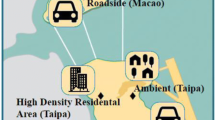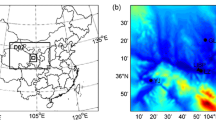Abstract
The study of atmospheric concentration levels at a local scale is one of the most important topics in environmental sciences. Multivariate analysis, fuzzy logic, and neural networks have been introduced in forecasting procedures in order to elaborate operational techniques for level characterization of specific atmospheric pollutants at different spatial and temporal scales. Particularly, approaches based on artificial neural networks (ANNs) have been proposed and successfully applied for forecasting concentration levels of PM10, NO2, SO2, CO, and O3. The present study explores the development and application of ANN models for forecasting, 24 h ahead, not only the daily concentration levels of PM10 but also the number of hours exceeding the PM10 concentration threshold during the day in five different regions within the greater Athens area (GAA). The ANN modeling was based on measurements and estimates of the mean daily PM10 concentration, the maximum hourly NO2 concentration, air temperature, relative humidity, wind speed, and the mode daily value of wind direction from five different monitoring stations for the period 2001–2005. The evaluation of the model performance showed the risk of daily PM10 concentration levels exceeding certain thresholds as well as the duration of the exceedances can be successfully predicted. Despite the limitations of the model, the results indicate that ANNs, when adequately trained, have considerable potential to be used for 1 day ahead PM10 concentration forecasting and the duration within the GAA.




Similar content being viewed by others
References
Asadisaghandi, J., & Tahmasebi, P. (2011). Comparative evaluation of back propagation neural network learning algorithms and empirical correlations for prediction of oil PVT properties in Iran oilfields. Journal of Petroleum Science and Engineering, 78, 464–475.
Crow, E. L., David, F. A., & Maxfield, M. W. (1960). Statistics manual. New York, USA: Dover.
Directive 2008/50/EC of the European Parliament and of the Council of 21 May 2008, on ambient air quality and cleaner air for Europe. Official Journal of the European Union, L152/1-L152/44.
Dockery, D. W., & Pope, C. A. (1994). Acute respiratory effects of particulate air pollution. Annual Review of Public Health, 15, 107–132.
Dockery, D. W., Schwartz, J., & Spengler, J. D. (1992). Air pollution and daily mortality: association with particulates and acid aerosols. Environmental Research, 59, 362–373.
Dockery, D. W., Pope, C. A., Xu, X., Spengler, J. D., Ware, J. H., Fay, M. E., et al. (1993). An association between air pollution and mortality in six US cities. The New England Journal of Medicine, 329, 1735–1759.
Finlayson-Pitts, B. J., & Pitts, J. N., Jr. (2000). Chemistry of the upper and lower atmosphere: theory, experiments and applications (pp. 608–611). San Diego: Academic.
Grigoropoulos, K. N., Nastos, P. T., Ferentinos, G., Gialouris, A., Vasiliou, T., Mavroidakos, J., et al. (2008). Spatial distribution of PM1 and Sinus Arrhythmias in Athens, Greece. Fresenius Environmental Bulletin, 17, 1426–1431.
Grivas, G., & Chaloulakou, A. (2006). Artificial neural network models for prediction of PM10 hourly concentrations, in the Greater Area of Athens, Greece. Atmospheric Environment, 40, 1216–1229.
Hooyberghs, J., Mensink, C., Dumont, G., Fierens, F., & Brasseur, O. (2005). A neural network forecast for daily average PM10 concentrations in Belgium. Atmospheric Environment, 39, 3279–3289.
Hrdličková, Z., Michálek, J., Kolář, M., & Veselý, V. (2008). Identification of factors affecting air pollution by dust aerosol PM10 in Brno City, Czech Republic. Atmospheric Environment, 42, 8661–8673.
Larissi, I. K., Koukouletsos, K. V., Moustris, K. P., Antoniou, A., & Paliatsos, A. G. (2010). PM10 concentrations levels in the greater Athens area, Greece. Fresenius Environmental Bulletin, 19, 226–231.
Lee, C. K., Ho, D. S., Yu, C. C., & Wang, C. C. (2003). Fractal analysis of temporal variation of air pollutant concentration by box counting. Environmental Modelling and Software, 18(3), 243–251.
Lu, H. C., & Fang, G. C. (2002). Estimating the frequency distributions of PM10 and PM2.5 by the statistics of wind speed at Sha-Lu, Taiwan. The Science of the Total Environment, 298, 119–130.
McCulloh, W. S., & Pitts, W. (1943). A logical calculus of ideas immanent in Nervous activity. Bull Mathematical Biophysics, 5, 115–133.
Moustris, K. P., Ziomas, I. C., & Paliatsos, A. G. (2010). 3-Day-ahead forecasting of regional pollution index for the pollutants NO2, CO, SO2, and O3 using artificial neural networks in Athens, Greece. Water, Air, and Soil Pollution, 209, 29–43.
Murtoniemi, E., Yliruusi, J., & Kinnunen, P. (1994). The advantages by the use of neural networks in modelling the fluidized bed granulation process. International Journal of Pharmaceutics, 108, 155–164.
Nastos, P. T., Paliatsos, A. G., Anthracopoulos, M. B., Roma, E. S., & Priftis, K. N. (2010). Outdoor particulate matter and childhood asthma admissions in Athens, Greece: a time-series study. Environmental Health 9:45. doi:10.1186/1476-069X-9-45.
Ostro, B. D., Eskeland, G. S., Sanchez, J. M., & Feyzioglou, T. (1999). Air pollution and health effects: a study of medical visits among children in Santiago, Chile. Environmental Health Perspectives, 107, 69–73.
Panofsky, H. A., & Brier, G. W. (1968). Some applications of statistics to meteorology (pp. 159–161). Pennsylvania: University Park.
Papanastasiou, D. K., Melas, D., & Kioutsioukis, I. (2007). Development and assessment of neural network and multiple regression models in order to predict PM10 levels in a medium-sized Mediterranean city. Water, Air, and Soil Pollution, 182, 325–334.
Perez, P., & Reyes, J. (2002). Prediction of maximum of 24-h average of PM10 concentrations 30 h in advance in Santiago, Chile. Atmospheric Environment, 36, 4555–4561.
Pope, C. A., 3rd. (2000). Epidemiology of fine particulate air pollution and human health: biological mechanisms and who's at risk? Environmental Health Perspectives, 108, 713–723.
Pope, C. A., et al. (1995). Particulate air pollution as a predictor of mortality in a prospective study of U.S. adults. American Journal of Respiratory and Critical Care Medicine, 151, 669–674.
Sanchez, M. L., Pascual, D., Ramos, C., & Perez, I. (1990). Forecasting particulate pollutant concentrations in a city from meteorological variables and regional weather patterns. Atmospheric Environment, 24A(6), 1509–1519.
Schwartz, J., Slater, D., Larson, T., Pierson, W. E., & Koeng, J. Q. (1991). Particulate air pollution and hospital emergency room visits for asthma in Seattle. American Journal of Respiratory and Critical Care Medicine, 147, 826–831.
Seaton, A., MacNee, W., Donaldson, K., & Godden, D. (1995). Particulate air pollution and acute health effects. Lancet, 345, 176–178.
Sfetsos, A., & Vlachogiannis, D. (2009) An investigation of the effectiveness of advanced modeling tools on the forecasting of daily PM10 values in the Greater Athens Area. Information Technologies in Environmental Engineering, Environmental Science and Engineering, pp 305–316. doi:10.1007/978-3-540-88351-7_23.
Sfetsos, A., & Vlachogiannis, D. (2010). A new methodology development for the regulatory forecasting of PM10. Application in the Greater Athens Area, Greece. Atmospheric Environment, 44, 3159–3172.
Shekarrizfard, M., Karimi-Jashni, A., & Hadad, K. (2011). Wavelet transform-based artificial neural networks (WT-ANN) in PM10 pollution level estimation, based on circular variables. Environmental Science and Pollution Research. doi:10.1007/s11356-011-0554-9.
Slini, T., Kaprara, A., Karatzas, K., & Moussiopoulos, N. (2006). PM10 forecasting for Thessaloniki, Greece. Environmental Modelling & Software, 21, 559–565.
Tu, J. V. (1996). Advantages and disadvantages of using artificial neural networks versus logistic regression for predicting medical outcomes. Journal of Clinical Epidemiology, 49(11), 1225–1231.
Van der Wal, J. T., & Janssen, L. H. J. M. (2000). Analysis of spatial and temporal variations of PM10 concentrations in the Netherlands using Kalman filtering. Atmospheric Environment, 34(22), 3675–3687.
Vlachogianni, A., Kassomenos, P., Karppinen, A., Karakitsios, S., & Kukkonen, J. (2011). Evaluation of a multiple regression model for the forecasting of the concentrations of NOx and PM10 in Athens and Helsinki. Science of the Total Environment, 409, 1559–1571.
WHO (2013). Air quality and health. Available at: http://www.who.int/mediacentre/factsheets/fs313/en/
Xu, J., Chen, B., & Liang, H. (2008). Accurate prediction of θ (lower critical solution temperature) in polymer solutions based on 3D descriptors and artificial neural networks. Macromolecular Theory and Simulations, 17(2–3), 109–120.
Author information
Authors and Affiliations
Corresponding author
Rights and permissions
About this article
Cite this article
Moustris, K.P., Larissi, I.K., Nastos, P.T. et al. Development and Application of Artificial Neural Network Modeling in Forecasting PM10 Levels in a Mediterranean City. Water Air Soil Pollut 224, 1634 (2013). https://doi.org/10.1007/s11270-013-1634-x
Received:
Accepted:
Published:
DOI: https://doi.org/10.1007/s11270-013-1634-x




